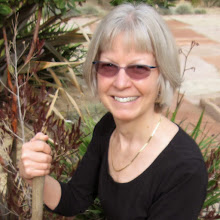Large Trees in “Girard” Tract of Woodland Hills -- especially Costanso Neighborhood Watch Group section
Janis Hatlestad, Better Earth Garden Design (begarden.com), Woodland Hills, CA
Urban Forest Ecosystems Institute at Cal Poly, San Luis Obispo has developed a website application called “SelecTree”. That page contains a search box in which can be input a tree’s botanical or common name. Listed below are some of the prevalent older trees in our neighborhood that are in the SelecTree database. Both types of names are shown (Genus species, Common Name(s)) with link to the appropriate SelecTree page. You might find your street tree among this short list. My understanding is these original trees were planted by Girard approximately 90 years ago (+/- 5 years). Most of them appear to fall into the longevity category of 50 to 150 years. Fifty would be in more adverse conditions, while 150 life span would be achieved through more optimal care throughout a tree’s lifetime. Some of these trees, of course, may live much longer in their native land in association with both fauna and other flora of their communities.
Photographs as well as pertinent attributes of the trees are contained in these pages. This may help you to identify your particular street tree or trees. For example, form, shape, and size characteristics of each tree species. Pest and Disease resistance and susceptibility, Branch Strength, Fire Resistance, expected climate adaptation identified by “Sunset Zone” and “USDA (cold-hardiness) Zone” are also included. We are primarily Sunset Zone 18 in the flats and cold air drains, and rather more like Sunset Zone 19 in thermal belts along the foothills, as we have little of the coastal air influence enjoyed in most other areas of Los Angeles. USDA Zone here is I believe 9a (average annual extreme minimum temperature for 1976-2005), although in some years we’ve felt more like 8b. Specific cold hardiness ranges for each tree species are also listed as available.
Many of our trees -- the Bottle Tree (Kurrajong), as well as the Gums -- are native to Australia, which has some similar climate areas. Being just slightly smaller in size than the contiguous United States, Australia also has many climate areas dissimilar to ours.
Brachychiton populneus, KURRAJONG or BOTTLE TREE
Eucalyptus camaldulensis, RIVER RED GUM
Eucalyptus polyanthemos, SILVER DOLLAR GUM
Eucalyptus robusta, SWAMP MAHOGANY
Eucalyptus rudis, FLOODED GUM*
Eucalyptus tereticornis, FOREST RED GUM
Schinus molle, PERUVIAN PEPPER TREE**
** Also called California Pepper Tree, although not native to California.
Urban Forest Ecosystems Institute at Cal Poly, San Luis Obispo has developed a website application called “SelecTree”. That page contains a search box in which can be input a tree’s botanical or common name. Listed below are some of the prevalent older trees in our neighborhood that are in the SelecTree database. Both types of names are shown (Genus species, Common Name(s)) with link to the appropriate SelecTree page. You might find your street tree among this short list. My understanding is these original trees were planted by Girard approximately 90 years ago (+/- 5 years). Most of them appear to fall into the longevity category of 50 to 150 years. Fifty would be in more adverse conditions, while 150 life span would be achieved through more optimal care throughout a tree’s lifetime. Some of these trees, of course, may live much longer in their native land in association with both fauna and other flora of their communities.
Photographs as well as pertinent attributes of the trees are contained in these pages. This may help you to identify your particular street tree or trees. For example, form, shape, and size characteristics of each tree species. Pest and Disease resistance and susceptibility, Branch Strength, Fire Resistance, expected climate adaptation identified by “Sunset Zone” and “USDA (cold-hardiness) Zone” are also included. We are primarily Sunset Zone 18 in the flats and cold air drains, and rather more like Sunset Zone 19 in thermal belts along the foothills, as we have little of the coastal air influence enjoyed in most other areas of Los Angeles. USDA Zone here is I believe 9a (average annual extreme minimum temperature for 1976-2005), although in some years we’ve felt more like 8b. Specific cold hardiness ranges for each tree species are also listed as available.
Many of our trees -- the Bottle Tree (Kurrajong), as well as the Gums -- are native to Australia, which has some similar climate areas. Being just slightly smaller in size than the contiguous United States, Australia also has many climate areas dissimilar to ours.
Brachychiton populneus, KURRAJONG or BOTTLE TREE
Eucalyptus camaldulensis, RIVER RED GUM
Eucalyptus polyanthemos, SILVER DOLLAR GUM
Eucalyptus robusta, SWAMP MAHOGANY
Eucalyptus rudis, FLOODED GUM*
Eucalyptus tereticornis, FOREST RED GUM
Schinus molle, PERUVIAN PEPPER TREE**
_______________________________________
* Not to be confused with Eucalyptus grandis, also called “FLOODED GUM”. ** Also called California Pepper Tree, although not native to California.
_______________________________________
As time permits and I observe additional trees in our neighborhood forest, I will update the list, especially to include more recently planted
replacement trees.
SelecTree.com, Urban Forest Ecosystems Institute at Cal Poly, San Luis Obispo.
PlantHardiness, USDA Agricultural Research Service
Sunset climate zones: Los Angeles region, Sunset.com
Other sources:
A Californian’s Guide to the Trees Among Us, Matt Ritter, Heyday Books, Berkeley, CA 2011. TreePeople.org, especially the publication “HELP YOUR TREES SURVIVE THE DROUGHT”
Eucalyptus Redgum Lerp Psyllid, UCANR, UC IPM Online, Statewide Integrated Pest Management Program
Copyright: Janis Hatlestad, Better Earth Garden Design (begarden.com), 2014
________________________________________
References:
SelecTree.com, Urban Forest Ecosystems Institute at Cal Poly, San Luis Obispo.
PlantHardiness, USDA Agricultural Research Service
Sunset climate zones: Los Angeles region, Sunset.com
Other sources:
A Californian’s Guide to the Trees Among Us, Matt Ritter, Heyday Books, Berkeley, CA 2011. TreePeople.org, especially the publication “HELP YOUR TREES SURVIVE THE DROUGHT”
Eucalyptus Redgum Lerp Psyllid, UCANR, UC IPM Online, Statewide Integrated Pest Management Program
Copyright: Janis Hatlestad, Better Earth Garden Design (begarden.com), 2014





No comments:
Post a Comment